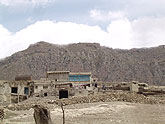|
|
|
|
|
|
|
| |
| |
Panorama
of settlement Budug |
| |
Panorama
of settlement Budug |
| |
Panorama
of settlement Budug |
| |
Panorama
of settlement Budug |
 |
Kara-Chai
canyon |
 |
Panorama
of settlement Budug |
 |
Panorama
of settlement Budug |
 |
Panorama
of settlement Budug |
|
Settlement
Budug
(Kuba area)
HISTORY
The
Budugs speaking in the Budug language live in the
village Budug. The ethnic group of the Budugs is little
studied in the historical and ethnographic respect.
Elements of the Budugs' culture, as well as their
language, are very close to the Kriz's. As to legends,
Budug was founded in epoch of the Caucasian Albania.
It is located in a remote place so that inhabitants
could be rescued from attacks of Sasanidian armies
(from the year of 267 to 651 a part of territories
of northern Azerbaijan has been grasped by armies
of Iranian state of the Sasanids).
The Budugs live separately as the roads leading into
the settlement, are practicable only in summer season.
Since ancient times the Budugs have been residing
in this place. Near the village, in location Gulkhana
and on the mountain Ambara, there were saved old caves
evidencing ancient settling.
The word "budug" in the ancient Turkish language stands
for "angry", "violent". They consider inhabitants
of neighbor settlements in view of their pronounced
characteristic features gave this name to them. The
budugs name themselves "budad".
For the first time the historic fact with regard to
the Budugs is given in the treatise "Jame at-tavarikh"
by Fazdullah Rashidaddin, the historian of the end
of XIII and the beginning of XIV centuries. The author
mentions that this dynasty comes from Tombin khan's
fifth son Bath Kulkin. In days of Chingiz khan their
head was Huriday. When Chingiz khan battled against
Tajiut's dynasty, the Budugs and Chingiz khan were
allies, and their armies were incorporated.
The first official document regarding the Budugs is
a decree of 1607 published by governor of Sefevid
state Shah Abbas I. Decrees of Kuba khans Hasanali-khan,
Fatali-khan, Sheikh Ali-khan about Budug and the Budugs
published in 18 to the early 19 centuries have a special
value. And these decrees play a special role in studying
of history of Budug and the Budugs. A.Bakihanov mentions
Budug and the Budugs in his work "Gulustani-Iram".
In XIX century Budug was the center of administrative
division mahal.
Historically the Budugs divide on big and small families,
on dynasties. On a rural cemetery each dynasty has
his place.
Prior to the beginning of XX century population of
Budug made 2500 - 3500 persons. At present there live
200-300 persons in this settlement. In connection
with social and economic problems the most part of
the population has left this place.
|